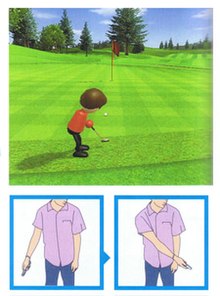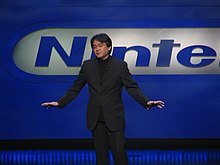
The Wii is a home video game console developed and marketed by Nintendo. It was released on November 19, 2006 in North America, and in December 2006 for most other regions of the world. It is Nintendo's fifth major home game console, following the GameCube and is a seventh-generation console alongside Microsoft's Xbox 360 and Sony's PlayStation 3.

Mario Power Tennis is a sports game developed by Camelot Software Planning and published by Nintendo. The game is the sequel to the Nintendo 64 title Mario Tennis, and is the fourth game in the Mario Tennis series. Power Tennis was released for the GameCube in Japan and North America in late 2004, and in PAL regions in early 2005. The game was ported for the Wii in 2009 as part of the New Play Control! series, and was also re-released as a Nintendo Selects title in 2012. A companion handheld game, Mario Tennis: Power Tour, was also released on Game Boy Advance around the same time as the original GameCube release, bearing the same title as Power Tennis in Europe.

Metroid Prime 3: Corruption is a 2007 action-adventure game developed by Retro Studios and published by Nintendo for the Wii. The seventh main game in the Metroid series, it was released in North America and Europe in 2007 and in Japan the following year.

Mario Artist is an interoperable suite of three games and one Internet application for Nintendo 64: Paint Studio, Talent Studio, Polygon Studio, and Communication Kit. These flagship disks for the 64DD peripheral were developed to turn the game console into an Internet multimedia workstation. A bundle of the 64DD unit, software disks, hardware accessories, and the Randnet online service subscription package was released in Japan starting in December 1999.

WarioWare: Smooth Moves is a party video game developed by Nintendo SPD and Intelligent Systems. The game was published by Nintendo for its Wii video game system in Japan in December 2006, and in Europe, North America, and Australia in January 2007. It is the fifth game in the WarioWare series of games, and the only game in the series to be physically released for the Wii. Like its predecessors, WarioWare: Smooth Moves is built around a collection of microgames that last about five seconds each, and which require that the player hold the Wii Remote in specific positions. The game offers the microgames to the player in rapid succession, by first instructing the player to hold the Wii Remote in a specific manner, and then showing them the microgame. The microgames are divided into several stages, each of which loosely connects the microgames with the help of a story. Additionally, this was the first spin-off Mario game to be released for the console.
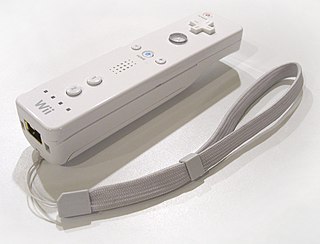
The Wii Remote, also known colloquially as the Wiimote, is the primary game controller for Nintendo's Wii home video game console. An essential capability of the Wii Remote is its motion sensing capability, which allows the user to interact with and manipulate items on screen via motion sensing, gesture recognition, and pointing using an accelerometer and optical sensor technology. It is expandable by adding attachments. The attachment bundled with the Wii console is the Nunchuk, which complements the Wii Remote by providing functions similar to those in gamepad controllers. Some other attachments include the Classic Controller, Wii Zapper, and the Wii Wheel, which was originally released with the racing game, Mario Kart Wii.

Donkey Kong Barrel Blast is a 2007 racing game for Nintendo's Wii video game console. The game was shown at the E3 convention in May 2006 for the GameCube under the title of DK: Bongo Blast, but this version was ultimately cancelled in favor of a Wii release. It was released for the Wii in Japan and the United States in 2007, and in PAL regions in 2008 with the title Donkey Kong Jet Race.

Wii Music is a music video game developed and published by Nintendo for the Wii video game console. The game was released in Japan and North America in October 2008, and in Europe and Australia in the following month. Wii Music is part of both Nintendo's Touch! Generations brand and the Wii series.
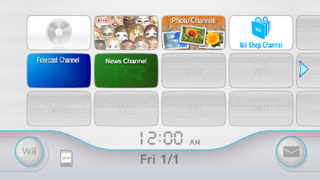
The Wii Menu is the graphical shell of the Wii and Wii U game console, as part of the Wii system software. It has four pages, each with a 4:3 grid, and each displaying the current time and date. Available applications, known as "channels", are displayed and can be navigated using the pointer capability of the Wii Remote. The grid is customizable; users can move channels among the menu's 48 customizable slots. By pressing the plus and minus buttons on the Wii Remote users can scroll across accessing empty slots.

Wii Play is a party video game developed and published by Nintendo for the Wii console. It was released as a launch game for the console in Japan, Europe, and Australia in December 2006, and was released in North America in February 2007. The game features nine minigames, including a Duck Hunt-esque shooting range, a fishing game, and a billiards game, each of which are designed to showcase the features of the Wii Remote controller.

Kororinpa is a video game for Nintendo's Wii video game console. It was released in Japan on December 2, 2006 as a launch title for the Wii, then in Europe on February 23, 2007 and North America on March 20, 2007.

A Mii is a customizable avatar used on several Nintendo video game consoles and mobile apps. The name Mii is a portmanteau of "Wii" and "me", referring to them typically being avatars of the players. Miis were first introduced on the Wii console in 2006 and later appeared on the DS, 3DS, the Wii U, the Switch, and various apps for smart devices such as Miitomo. Miis can be created using different body, facial and clothing features, and can then be used as characters within games on the consoles, either as an avatar of a specific player or in some games portrayed as characters with their own personalities. Miis can be shared and transferred between consoles, either manually or automatically with other users over the internet and local wireless communications.

Mario & Sonic at the Olympic Games is a 2007 crossover sports and party game developed by the Sega Sports R&D Department. It is the first installment on the Mario & Sonic series. It was published by Nintendo in Japan and by Sega in other regions, and released on the Wii in November 2007 and the Nintendo DS handheld in January 2008. The first official video game of the 2008 Summer Olympic Games, it is licensed by the International Olympic Committee (IOC) through exclusive licensee International Sports Multimedia (ISM), and is the first official crossover game to feature characters from both the Mario and Sonic the Hedgehog series.

Mario Kart Wii is a 2008 kart racing game developed and published by Nintendo for the Wii. It is the sixth installment in the Mario Kart series, and was released in April 2008. Like its previous installments, Mario Kart Wii incorporates playable characters from the Mario series, who participate in races on 32 different race tracks using specialized items to hinder opponents or gain advantages. The game features multiple single-player and multiplayer game modes including two- to four-person split screen. Online multiplayer was supported until the discontinuation of Nintendo Wi-Fi Connection in May 2014. Mario Kart Wii uses the Wii Remote's motion-controls to provide intuitive and conventional steering controls. Each copy of the game was bundled with the Wii Wheel accessory to augment this feature and mimic a steering wheel.

Wii Fit is a 2007 exergaming video game designed by Nintendo's Hiroshi Matsunaga for the Wii home video game console, featuring a variety of yoga, strength training, aerobics, and balance mini-games for use with the Wii Balance Board peripheral. Matsunaga described the game as a "way to help get families exercising together". It has since been adopted by various health clubs around the world, and has previously been used for physiotherapy rehabilitation in children and in nursing homes to improve posture in the elderly.
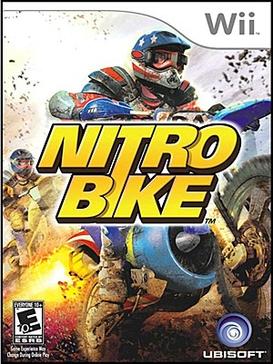
Nitrobike is a dirt-bike racing video game for the Wii and PlayStation 2. It is published by Ubisoft and was developed by Left Field Productions, the developer previously responsible for, among other games, Excitebike 64, MTX Mototrax and Dave Mirra BMX Challenge. It began development in October 2006, and was presented by Ubisoft at its E3 2007 press conference in Santa Monica, California. Initially exclusive as Wii title, it was the first Motocross game for the Wii.

Super Smash Bros. Brawl is a 2008 crossover fighting game developed by Sora Ltd. and Game Arts and published by Nintendo for the Wii. The third installment in the Super Smash Bros. series, it was announced at a pre-E3 2005 press conference by Nintendo president Satoru Iwata. Masahiro Sakurai, director of the previous two games in the series, assumed the role of director at Iwata's request. Game development began in October 2005 with a creative team that included members from several Nintendo and third-party development teams. After delays due to development problems, the game was released worldwide in 2008.
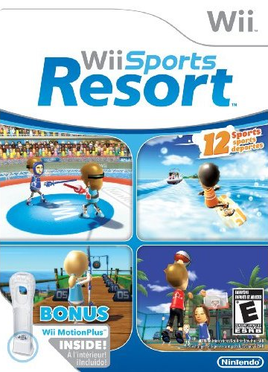
Wii Sports Resort is a 2009 sports simulation video game developed and published by Nintendo for the Wii video game console and is the sequel to Wii Sports. It is the first first-party Wii game to support the Wii MotionPlus accessory and the first one overall to require it, which was bundled with the game. Wii Sports Resort was first announced at E3 2008 and was released in Japan on June 25, 2009, and in nearly all other regions the following month. While Wii Sports Resort was first released as a stand-alone title, it was later bundled with newer Wii consoles alongside Wii Sports.


